Economics: Neo-Keynesian & Classical Policies for Long Growth
VerifiedAdded on 2024/06/25
|10
|2986
|164
Essay
AI Summary
This essay discusses the contrasting viewpoints of Keynesian and classical supply-side economics concerning long-term economic growth, particularly within the context of European governments. It explains how Keynesian theory advocates for government intervention through increased spending and reduced taxes to stimulate aggregate demand, while classical theory emphasizes free markets and minimal government intervention. The essay also explores specific supply-side policies associated with each approach, highlighting the differing perspectives on the role of government in addressing economic recessions and fostering sustainable growth. Examples of policies adopted by European governments are mentioned, emphasizing the practical application of these economic theories.

ECONOMICS FOR BUSINESS
1
1
Paraphrase This Document
Need a fresh take? Get an instant paraphrase of this document with our AI Paraphraser
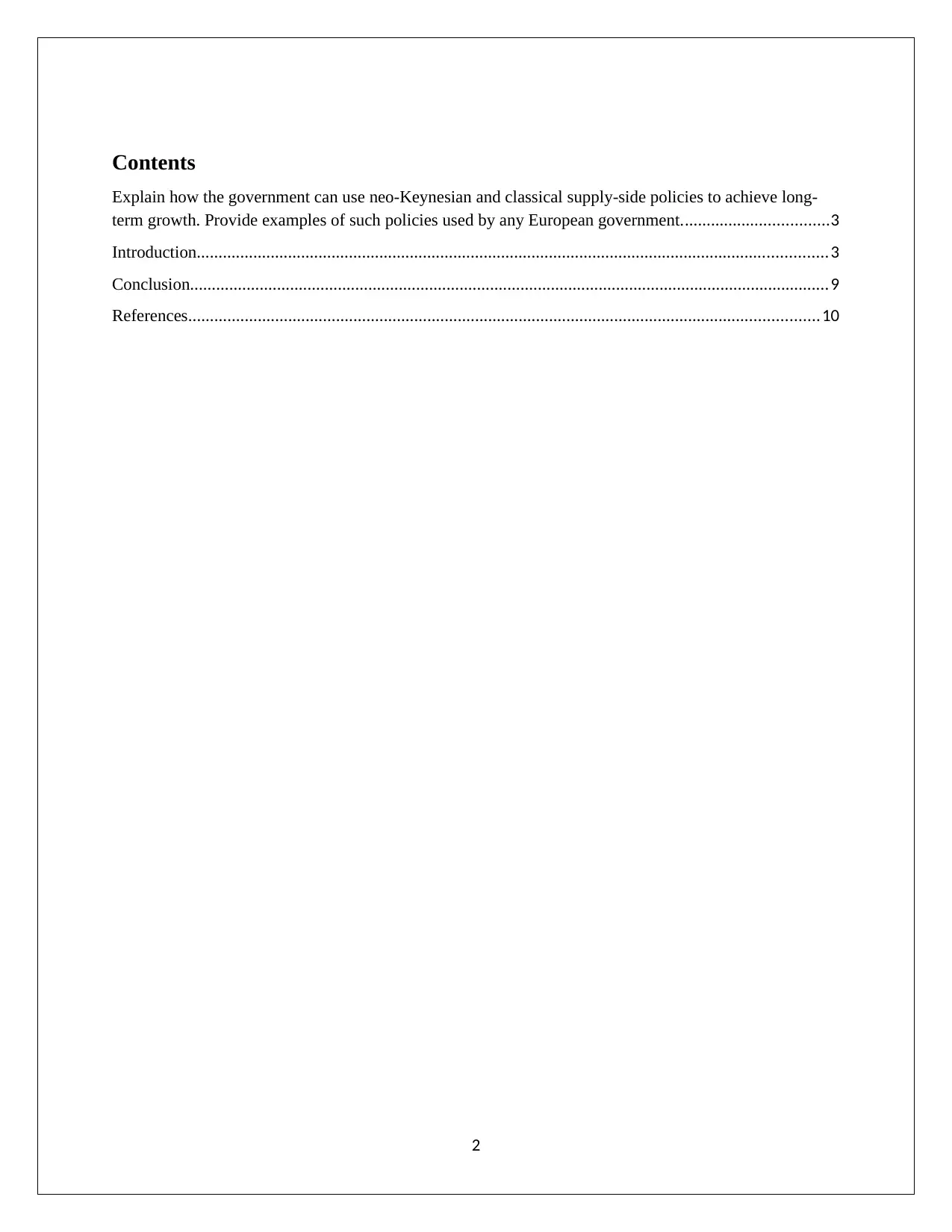
Contents
Explain how the government can use neo-Keynesian and classical supply-side policies to achieve long-
term growth. Provide examples of such policies used by any European government..................................3
Introduction.................................................................................................................................................3
Conclusion...................................................................................................................................................9
References.................................................................................................................................................10
2
Explain how the government can use neo-Keynesian and classical supply-side policies to achieve long-
term growth. Provide examples of such policies used by any European government..................................3
Introduction.................................................................................................................................................3
Conclusion...................................................................................................................................................9
References.................................................................................................................................................10
2
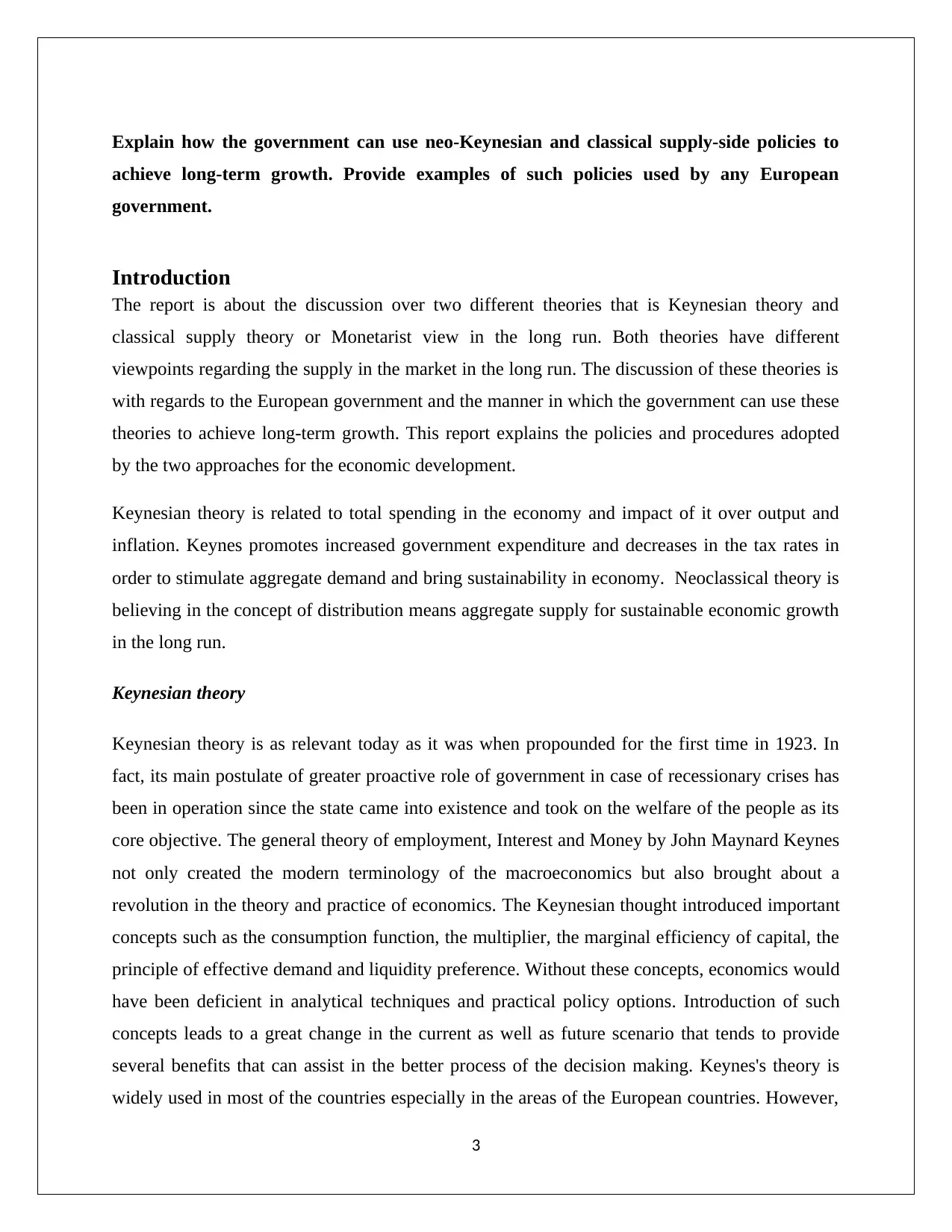
Explain how the government can use neo-Keynesian and classical supply-side policies to
achieve long-term growth. Provide examples of such policies used by any European
government.
Introduction
The report is about the discussion over two different theories that is Keynesian theory and
classical supply theory or Monetarist view in the long run. Both theories have different
viewpoints regarding the supply in the market in the long run. The discussion of these theories is
with regards to the European government and the manner in which the government can use these
theories to achieve long-term growth. This report explains the policies and procedures adopted
by the two approaches for the economic development.
Keynesian theory is related to total spending in the economy and impact of it over output and
inflation. Keynes promotes increased government expenditure and decreases in the tax rates in
order to stimulate aggregate demand and bring sustainability in economy. Neoclassical theory is
believing in the concept of distribution means aggregate supply for sustainable economic growth
in the long run.
Keynesian theory
Keynesian theory is as relevant today as it was when propounded for the first time in 1923. In
fact, its main postulate of greater proactive role of government in case of recessionary crises has
been in operation since the state came into existence and took on the welfare of the people as its
core objective. The general theory of employment, Interest and Money by John Maynard Keynes
not only created the modern terminology of the macroeconomics but also brought about a
revolution in the theory and practice of economics. The Keynesian thought introduced important
concepts such as the consumption function, the multiplier, the marginal efficiency of capital, the
principle of effective demand and liquidity preference. Without these concepts, economics would
have been deficient in analytical techniques and practical policy options. Introduction of such
concepts leads to a great change in the current as well as future scenario that tends to provide
several benefits that can assist in the better process of the decision making. Keynes's theory is
widely used in most of the countries especially in the areas of the European countries. However,
3
achieve long-term growth. Provide examples of such policies used by any European
government.
Introduction
The report is about the discussion over two different theories that is Keynesian theory and
classical supply theory or Monetarist view in the long run. Both theories have different
viewpoints regarding the supply in the market in the long run. The discussion of these theories is
with regards to the European government and the manner in which the government can use these
theories to achieve long-term growth. This report explains the policies and procedures adopted
by the two approaches for the economic development.
Keynesian theory is related to total spending in the economy and impact of it over output and
inflation. Keynes promotes increased government expenditure and decreases in the tax rates in
order to stimulate aggregate demand and bring sustainability in economy. Neoclassical theory is
believing in the concept of distribution means aggregate supply for sustainable economic growth
in the long run.
Keynesian theory
Keynesian theory is as relevant today as it was when propounded for the first time in 1923. In
fact, its main postulate of greater proactive role of government in case of recessionary crises has
been in operation since the state came into existence and took on the welfare of the people as its
core objective. The general theory of employment, Interest and Money by John Maynard Keynes
not only created the modern terminology of the macroeconomics but also brought about a
revolution in the theory and practice of economics. The Keynesian thought introduced important
concepts such as the consumption function, the multiplier, the marginal efficiency of capital, the
principle of effective demand and liquidity preference. Without these concepts, economics would
have been deficient in analytical techniques and practical policy options. Introduction of such
concepts leads to a great change in the current as well as future scenario that tends to provide
several benefits that can assist in the better process of the decision making. Keynes's theory is
widely used in most of the countries especially in the areas of the European countries. However,
3
⊘ This is a preview!⊘
Do you want full access?
Subscribe today to unlock all pages.

Trusted by 1+ million students worldwide
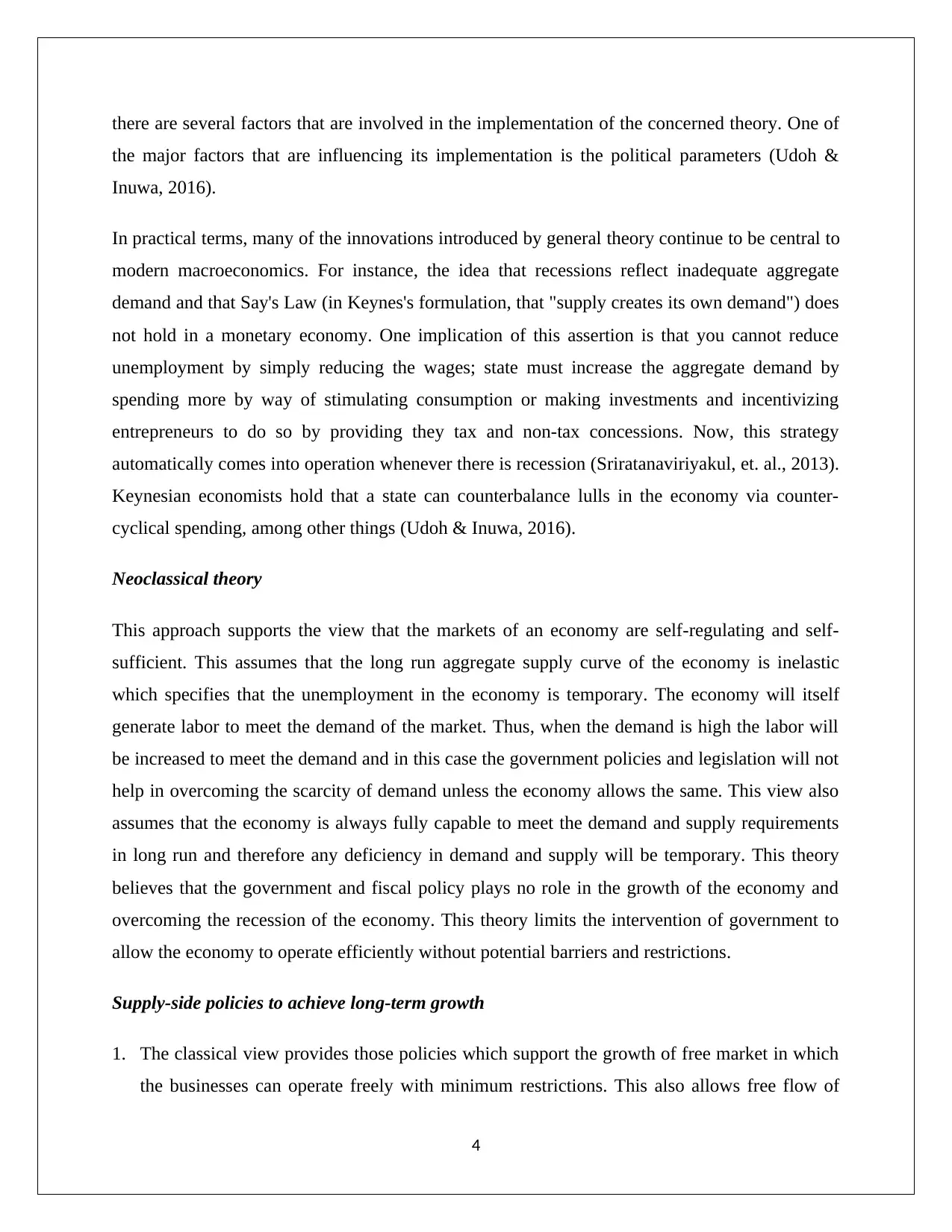
there are several factors that are involved in the implementation of the concerned theory. One of
the major factors that are influencing its implementation is the political parameters (Udoh &
Inuwa, 2016).
In practical terms, many of the innovations introduced by general theory continue to be central to
modern macroeconomics. For instance, the idea that recessions reflect inadequate aggregate
demand and that Say's Law (in Keynes's formulation, that "supply creates its own demand") does
not hold in a monetary economy. One implication of this assertion is that you cannot reduce
unemployment by simply reducing the wages; state must increase the aggregate demand by
spending more by way of stimulating consumption or making investments and incentivizing
entrepreneurs to do so by providing they tax and non-tax concessions. Now, this strategy
automatically comes into operation whenever there is recession (Sriratanaviriyakul, et. al., 2013).
Keynesian economists hold that a state can counterbalance lulls in the economy via counter-
cyclical spending, among other things (Udoh & Inuwa, 2016).
Neoclassical theory
This approach supports the view that the markets of an economy are self-regulating and self-
sufficient. This assumes that the long run aggregate supply curve of the economy is inelastic
which specifies that the unemployment in the economy is temporary. The economy will itself
generate labor to meet the demand of the market. Thus, when the demand is high the labor will
be increased to meet the demand and in this case the government policies and legislation will not
help in overcoming the scarcity of demand unless the economy allows the same. This view also
assumes that the economy is always fully capable to meet the demand and supply requirements
in long run and therefore any deficiency in demand and supply will be temporary. This theory
believes that the government and fiscal policy plays no role in the growth of the economy and
overcoming the recession of the economy. This theory limits the intervention of government to
allow the economy to operate efficiently without potential barriers and restrictions.
Supply-side policies to achieve long-term growth
1. The classical view provides those policies which support the growth of free market in which
the businesses can operate freely with minimum restrictions. This also allows free flow of
4
the major factors that are influencing its implementation is the political parameters (Udoh &
Inuwa, 2016).
In practical terms, many of the innovations introduced by general theory continue to be central to
modern macroeconomics. For instance, the idea that recessions reflect inadequate aggregate
demand and that Say's Law (in Keynes's formulation, that "supply creates its own demand") does
not hold in a monetary economy. One implication of this assertion is that you cannot reduce
unemployment by simply reducing the wages; state must increase the aggregate demand by
spending more by way of stimulating consumption or making investments and incentivizing
entrepreneurs to do so by providing they tax and non-tax concessions. Now, this strategy
automatically comes into operation whenever there is recession (Sriratanaviriyakul, et. al., 2013).
Keynesian economists hold that a state can counterbalance lulls in the economy via counter-
cyclical spending, among other things (Udoh & Inuwa, 2016).
Neoclassical theory
This approach supports the view that the markets of an economy are self-regulating and self-
sufficient. This assumes that the long run aggregate supply curve of the economy is inelastic
which specifies that the unemployment in the economy is temporary. The economy will itself
generate labor to meet the demand of the market. Thus, when the demand is high the labor will
be increased to meet the demand and in this case the government policies and legislation will not
help in overcoming the scarcity of demand unless the economy allows the same. This view also
assumes that the economy is always fully capable to meet the demand and supply requirements
in long run and therefore any deficiency in demand and supply will be temporary. This theory
believes that the government and fiscal policy plays no role in the growth of the economy and
overcoming the recession of the economy. This theory limits the intervention of government to
allow the economy to operate efficiently without potential barriers and restrictions.
Supply-side policies to achieve long-term growth
1. The classical view provides those policies which support the growth of free market in which
the businesses can operate freely with minimum restrictions. This also allows free flow of
4
Paraphrase This Document
Need a fresh take? Get an instant paraphrase of this document with our AI Paraphraser
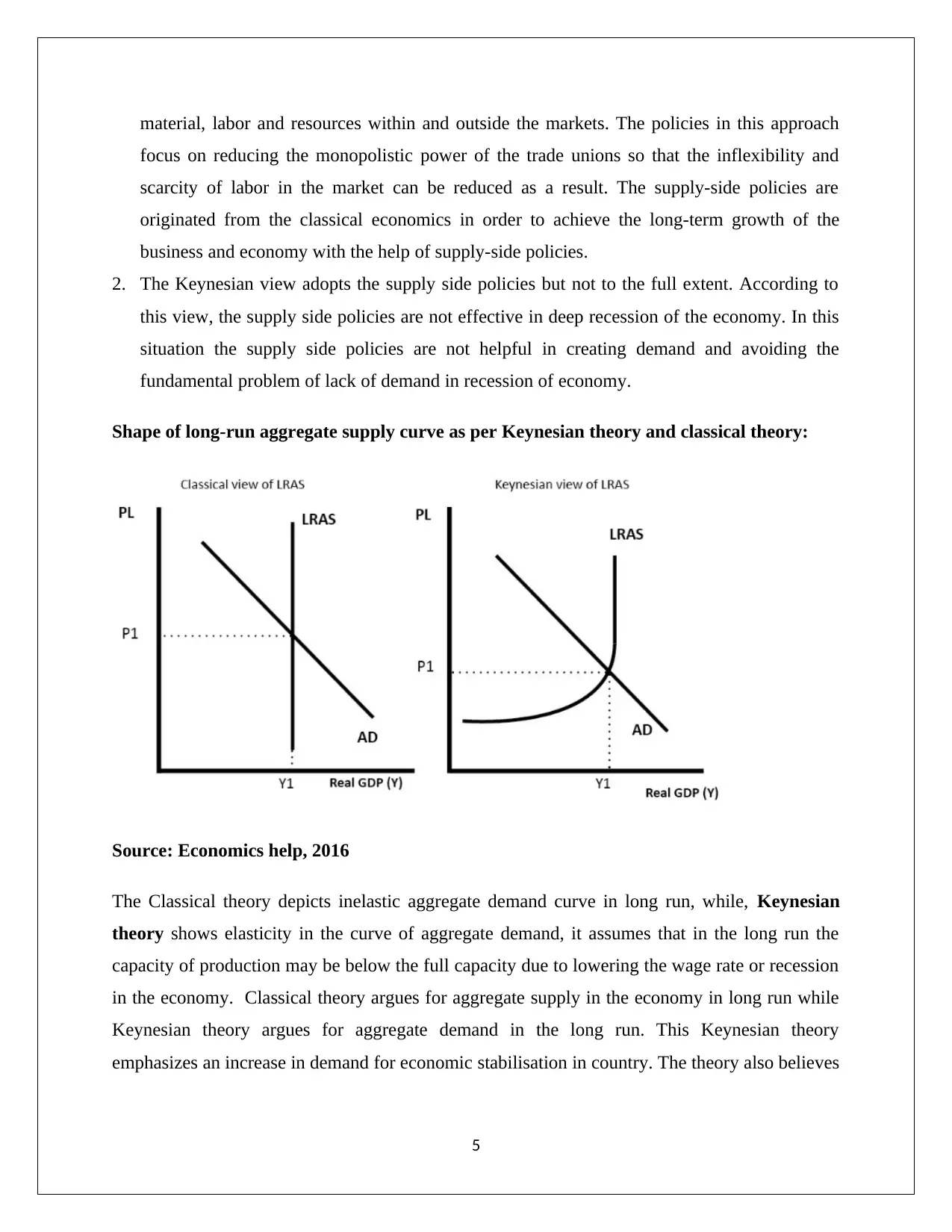
material, labor and resources within and outside the markets. The policies in this approach
focus on reducing the monopolistic power of the trade unions so that the inflexibility and
scarcity of labor in the market can be reduced as a result. The supply-side policies are
originated from the classical economics in order to achieve the long-term growth of the
business and economy with the help of supply-side policies.
2. The Keynesian view adopts the supply side policies but not to the full extent. According to
this view, the supply side policies are not effective in deep recession of the economy. In this
situation the supply side policies are not helpful in creating demand and avoiding the
fundamental problem of lack of demand in recession of economy.
Shape of long-run aggregate supply curve as per Keynesian theory and classical theory:
Source: Economics help, 2016
The Classical theory depicts inelastic aggregate demand curve in long run, while, Keynesian
theory shows elasticity in the curve of aggregate demand, it assumes that in the long run the
capacity of production may be below the full capacity due to lowering the wage rate or recession
in the economy. Classical theory argues for aggregate supply in the economy in long run while
Keynesian theory argues for aggregate demand in the long run. This Keynesian theory
emphasizes an increase in demand for economic stabilisation in country. The theory also believes
5
focus on reducing the monopolistic power of the trade unions so that the inflexibility and
scarcity of labor in the market can be reduced as a result. The supply-side policies are
originated from the classical economics in order to achieve the long-term growth of the
business and economy with the help of supply-side policies.
2. The Keynesian view adopts the supply side policies but not to the full extent. According to
this view, the supply side policies are not effective in deep recession of the economy. In this
situation the supply side policies are not helpful in creating demand and avoiding the
fundamental problem of lack of demand in recession of economy.
Shape of long-run aggregate supply curve as per Keynesian theory and classical theory:
Source: Economics help, 2016
The Classical theory depicts inelastic aggregate demand curve in long run, while, Keynesian
theory shows elasticity in the curve of aggregate demand, it assumes that in the long run the
capacity of production may be below the full capacity due to lowering the wage rate or recession
in the economy. Classical theory argues for aggregate supply in the economy in long run while
Keynesian theory argues for aggregate demand in the long run. This Keynesian theory
emphasizes an increase in demand for economic stabilisation in country. The theory also believes
5
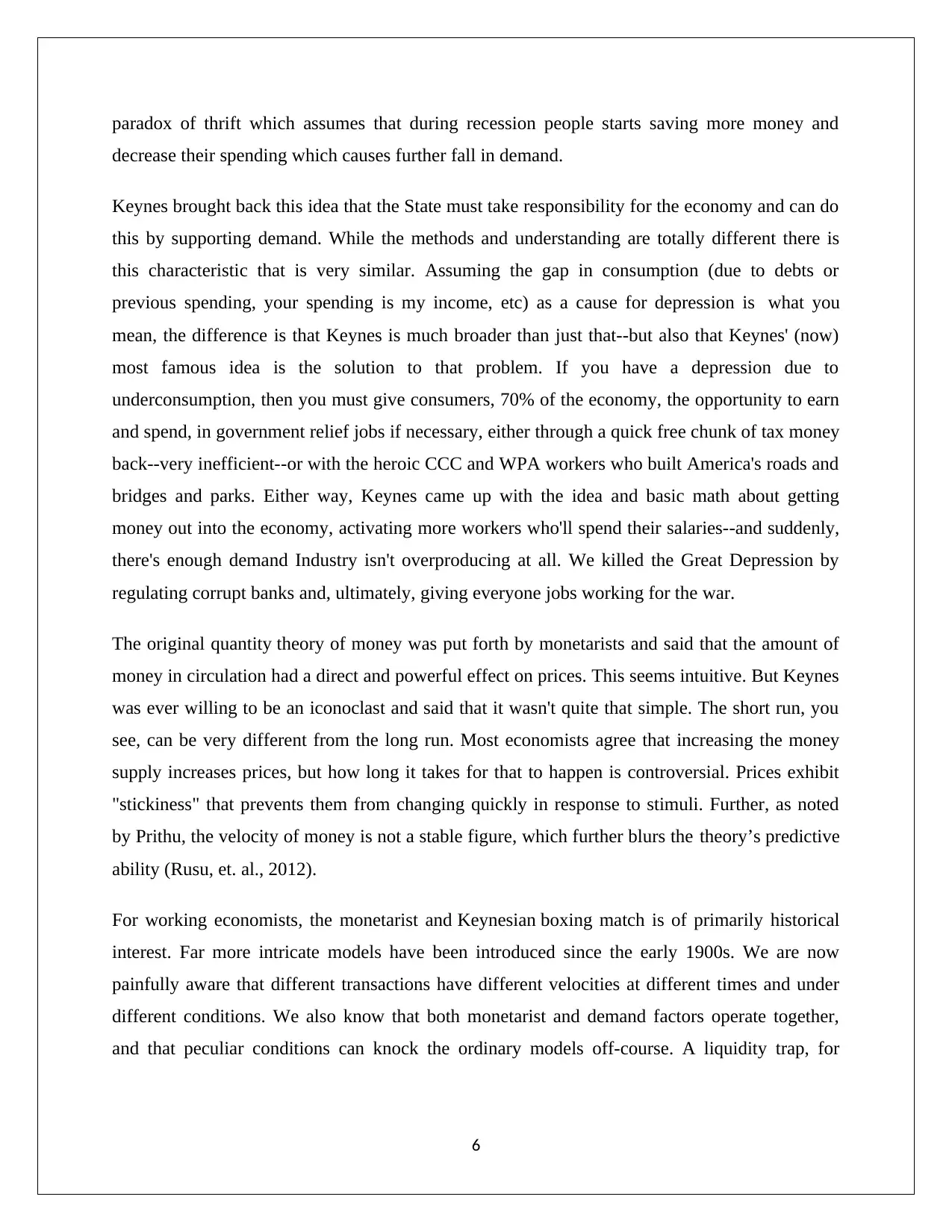
paradox of thrift which assumes that during recession people starts saving more money and
decrease their spending which causes further fall in demand.
Keynes brought back this idea that the State must take responsibility for the economy and can do
this by supporting demand. While the methods and understanding are totally different there is
this characteristic that is very similar. Assuming the gap in consumption (due to debts or
previous spending, your spending is my income, etc) as a cause for depression is what you
mean, the difference is that Keynes is much broader than just that--but also that Keynes' (now)
most famous idea is the solution to that problem. If you have a depression due to
underconsumption, then you must give consumers, 70% of the economy, the opportunity to earn
and spend, in government relief jobs if necessary, either through a quick free chunk of tax money
back--very inefficient--or with the heroic CCC and WPA workers who built America's roads and
bridges and parks. Either way, Keynes came up with the idea and basic math about getting
money out into the economy, activating more workers who'll spend their salaries--and suddenly,
there's enough demand Industry isn't overproducing at all. We killed the Great Depression by
regulating corrupt banks and, ultimately, giving everyone jobs working for the war.
The original quantity theory of money was put forth by monetarists and said that the amount of
money in circulation had a direct and powerful effect on prices. This seems intuitive. But Keynes
was ever willing to be an iconoclast and said that it wasn't quite that simple. The short run, you
see, can be very different from the long run. Most economists agree that increasing the money
supply increases prices, but how long it takes for that to happen is controversial. Prices exhibit
"stickiness" that prevents them from changing quickly in response to stimuli. Further, as noted
by Prithu, the velocity of money is not a stable figure, which further blurs the theory’s predictive
ability (Rusu, et. al., 2012).
For working economists, the monetarist and Keynesian boxing match is of primarily historical
interest. Far more intricate models have been introduced since the early 1900s. We are now
painfully aware that different transactions have different velocities at different times and under
different conditions. We also know that both monetarist and demand factors operate together,
and that peculiar conditions can knock the ordinary models off-course. A liquidity trap, for
6
decrease their spending which causes further fall in demand.
Keynes brought back this idea that the State must take responsibility for the economy and can do
this by supporting demand. While the methods and understanding are totally different there is
this characteristic that is very similar. Assuming the gap in consumption (due to debts or
previous spending, your spending is my income, etc) as a cause for depression is what you
mean, the difference is that Keynes is much broader than just that--but also that Keynes' (now)
most famous idea is the solution to that problem. If you have a depression due to
underconsumption, then you must give consumers, 70% of the economy, the opportunity to earn
and spend, in government relief jobs if necessary, either through a quick free chunk of tax money
back--very inefficient--or with the heroic CCC and WPA workers who built America's roads and
bridges and parks. Either way, Keynes came up with the idea and basic math about getting
money out into the economy, activating more workers who'll spend their salaries--and suddenly,
there's enough demand Industry isn't overproducing at all. We killed the Great Depression by
regulating corrupt banks and, ultimately, giving everyone jobs working for the war.
The original quantity theory of money was put forth by monetarists and said that the amount of
money in circulation had a direct and powerful effect on prices. This seems intuitive. But Keynes
was ever willing to be an iconoclast and said that it wasn't quite that simple. The short run, you
see, can be very different from the long run. Most economists agree that increasing the money
supply increases prices, but how long it takes for that to happen is controversial. Prices exhibit
"stickiness" that prevents them from changing quickly in response to stimuli. Further, as noted
by Prithu, the velocity of money is not a stable figure, which further blurs the theory’s predictive
ability (Rusu, et. al., 2012).
For working economists, the monetarist and Keynesian boxing match is of primarily historical
interest. Far more intricate models have been introduced since the early 1900s. We are now
painfully aware that different transactions have different velocities at different times and under
different conditions. We also know that both monetarist and demand factors operate together,
and that peculiar conditions can knock the ordinary models off-course. A liquidity trap, for
6
⊘ This is a preview!⊘
Do you want full access?
Subscribe today to unlock all pages.

Trusted by 1+ million students worldwide
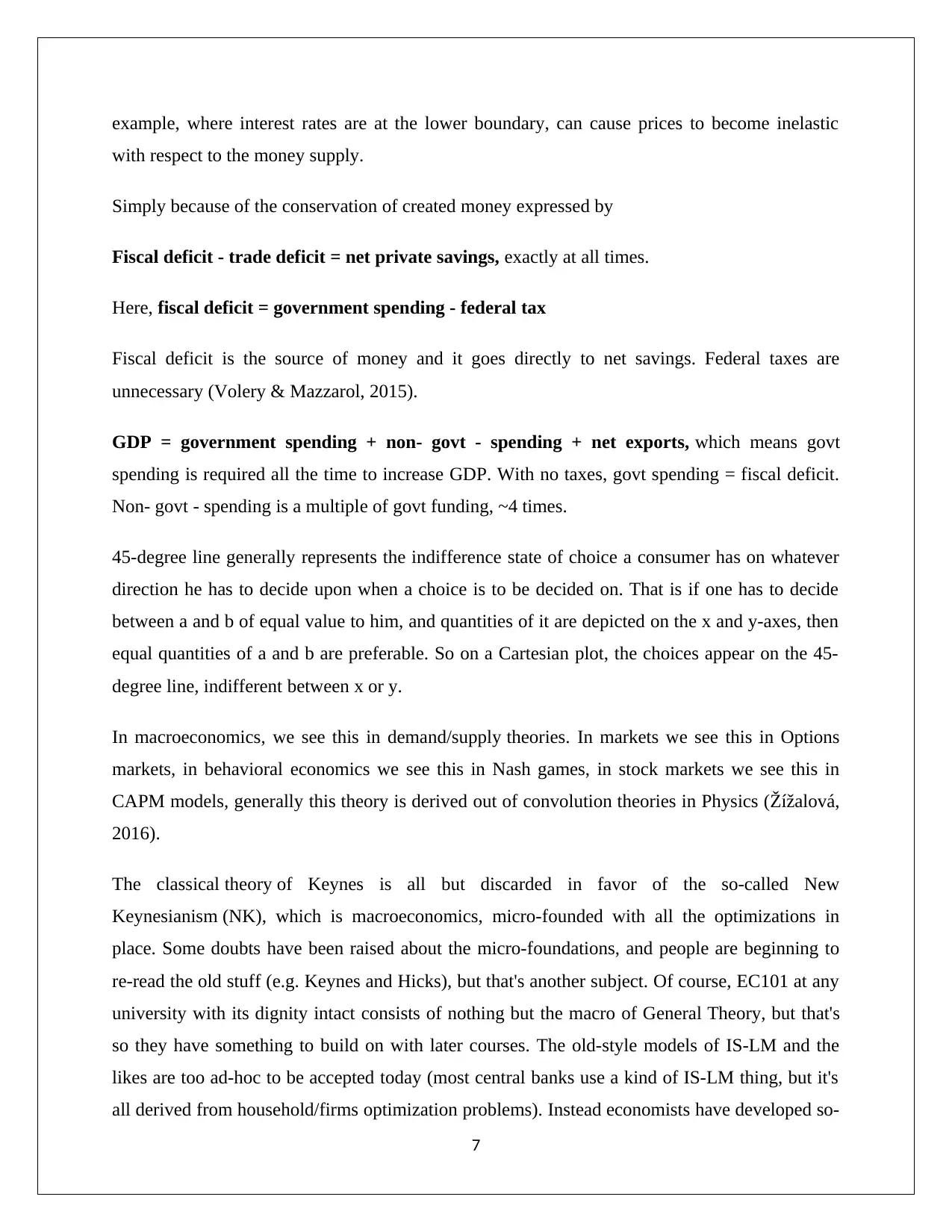
example, where interest rates are at the lower boundary, can cause prices to become inelastic
with respect to the money supply.
Simply because of the conservation of created money expressed by
Fiscal deficit - trade deficit = net private savings, exactly at all times.
Here, fiscal deficit = government spending - federal tax
Fiscal deficit is the source of money and it goes directly to net savings. Federal taxes are
unnecessary (Volery & Mazzarol, 2015).
GDP = government spending + non- govt - spending + net exports, which means govt
spending is required all the time to increase GDP. With no taxes, govt spending = fiscal deficit.
Non- govt - spending is a multiple of govt funding, ~4 times.
45-degree line generally represents the indifference state of choice a consumer has on whatever
direction he has to decide upon when a choice is to be decided on. That is if one has to decide
between a and b of equal value to him, and quantities of it are depicted on the x and y-axes, then
equal quantities of a and b are preferable. So on a Cartesian plot, the choices appear on the 45-
degree line, indifferent between x or y.
In macroeconomics, we see this in demand/supply theories. In markets we see this in Options
markets, in behavioral economics we see this in Nash games, in stock markets we see this in
CAPM models, generally this theory is derived out of convolution theories in Physics (Žížalová,
2016).
The classical theory of Keynes is all but discarded in favor of the so-called New
Keynesianism (NK), which is macroeconomics, micro-founded with all the optimizations in
place. Some doubts have been raised about the micro-foundations, and people are beginning to
re-read the old stuff (e.g. Keynes and Hicks), but that's another subject. Of course, EC101 at any
university with its dignity intact consists of nothing but the macro of General Theory, but that's
so they have something to build on with later courses. The old-style models of IS-LM and the
likes are too ad-hoc to be accepted today (most central banks use a kind of IS-LM thing, but it's
all derived from household/firms optimization problems). Instead economists have developed so-
7
with respect to the money supply.
Simply because of the conservation of created money expressed by
Fiscal deficit - trade deficit = net private savings, exactly at all times.
Here, fiscal deficit = government spending - federal tax
Fiscal deficit is the source of money and it goes directly to net savings. Federal taxes are
unnecessary (Volery & Mazzarol, 2015).
GDP = government spending + non- govt - spending + net exports, which means govt
spending is required all the time to increase GDP. With no taxes, govt spending = fiscal deficit.
Non- govt - spending is a multiple of govt funding, ~4 times.
45-degree line generally represents the indifference state of choice a consumer has on whatever
direction he has to decide upon when a choice is to be decided on. That is if one has to decide
between a and b of equal value to him, and quantities of it are depicted on the x and y-axes, then
equal quantities of a and b are preferable. So on a Cartesian plot, the choices appear on the 45-
degree line, indifferent between x or y.
In macroeconomics, we see this in demand/supply theories. In markets we see this in Options
markets, in behavioral economics we see this in Nash games, in stock markets we see this in
CAPM models, generally this theory is derived out of convolution theories in Physics (Žížalová,
2016).
The classical theory of Keynes is all but discarded in favor of the so-called New
Keynesianism (NK), which is macroeconomics, micro-founded with all the optimizations in
place. Some doubts have been raised about the micro-foundations, and people are beginning to
re-read the old stuff (e.g. Keynes and Hicks), but that's another subject. Of course, EC101 at any
university with its dignity intact consists of nothing but the macro of General Theory, but that's
so they have something to build on with later courses. The old-style models of IS-LM and the
likes are too ad-hoc to be accepted today (most central banks use a kind of IS-LM thing, but it's
all derived from household/firms optimization problems). Instead economists have developed so-
7
Paraphrase This Document
Need a fresh take? Get an instant paraphrase of this document with our AI Paraphraser

called DSGE-models, which basically are NK inventions. What really dealt the blow against the
classical Keynesianism was the stagflation of the 70's (once people built in the expected inflation
into their decisions, inflation did not lead to any growth), but it turned out policymakers had
gotten the wrong end of the stick, and even the stagflation could be explained in the context of
Keynes (Volery & Mazzarol, 2015).
The European government adopted the Keynesian theory so as to have the proper benefits that
may elaborate as:
Supports in the generation of the higher employment opportunities.
Supports in the stabilization of the industry dealing in the banking activities.
Supports in tightening the control of the expenditure of the government.
Supports in the suitable moderation of the rate of the interest.
Supports in the appropriate distinction between the saving, expenditure and investment.
Supports in the better examination of the aspects related to the factors of micro-economics.
As such it is advisable to the government to have proper enhancement of the knowledge of the
Keynesian theory so that appropriate measures can be taken leading to effective and advanced
results. Apart from that it will ensure to have a better position in the market arena (Rusu, et. al.,
2012). According to the neoclassical theory, European government should bring structural
reform such as promote free market economy of the country. Government can promote flexible
wages system which directly impacts upon the production level. But this reform does not help in
solving the major problem of unemployment (Thoma, 2013).
The neo Keynesian approach was adopted by the government of Germany to overcome the
recession. At the time of the global financial crisis, Berlin state government pumped an amount
of ten billion euros into the economy which resulted in the generation of hundreds of billions
from the German banks. After this, Germany soon became the motor of the entire European
economy. The modest economic recovery experienced by the European Union was the result of
the adoption of the Keynesian economics at the time of Global Financial Crisis by the European
government.
8
classical Keynesianism was the stagflation of the 70's (once people built in the expected inflation
into their decisions, inflation did not lead to any growth), but it turned out policymakers had
gotten the wrong end of the stick, and even the stagflation could be explained in the context of
Keynes (Volery & Mazzarol, 2015).
The European government adopted the Keynesian theory so as to have the proper benefits that
may elaborate as:
Supports in the generation of the higher employment opportunities.
Supports in the stabilization of the industry dealing in the banking activities.
Supports in tightening the control of the expenditure of the government.
Supports in the suitable moderation of the rate of the interest.
Supports in the appropriate distinction between the saving, expenditure and investment.
Supports in the better examination of the aspects related to the factors of micro-economics.
As such it is advisable to the government to have proper enhancement of the knowledge of the
Keynesian theory so that appropriate measures can be taken leading to effective and advanced
results. Apart from that it will ensure to have a better position in the market arena (Rusu, et. al.,
2012). According to the neoclassical theory, European government should bring structural
reform such as promote free market economy of the country. Government can promote flexible
wages system which directly impacts upon the production level. But this reform does not help in
solving the major problem of unemployment (Thoma, 2013).
The neo Keynesian approach was adopted by the government of Germany to overcome the
recession. At the time of the global financial crisis, Berlin state government pumped an amount
of ten billion euros into the economy which resulted in the generation of hundreds of billions
from the German banks. After this, Germany soon became the motor of the entire European
economy. The modest economic recovery experienced by the European Union was the result of
the adoption of the Keynesian economics at the time of Global Financial Crisis by the European
government.
8
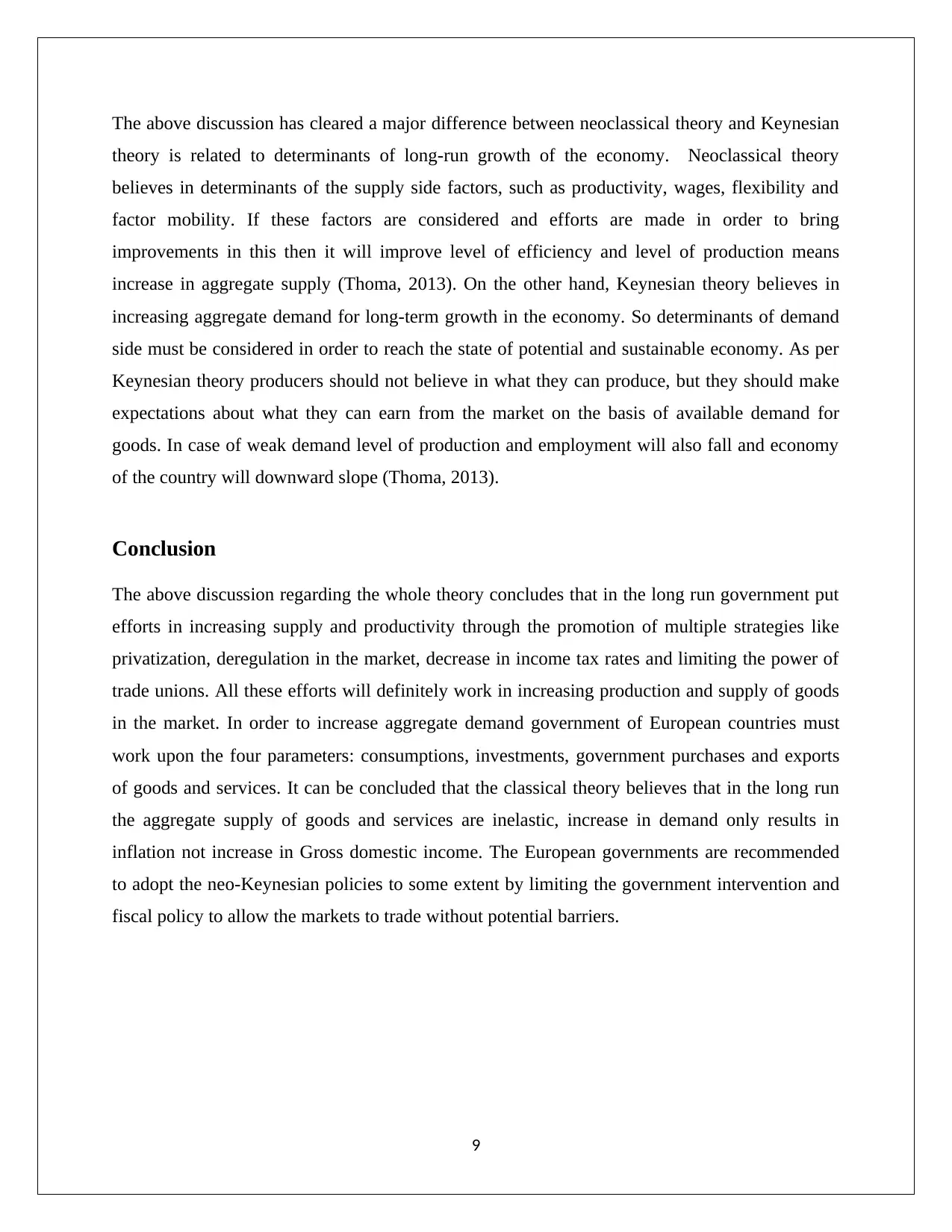
The above discussion has cleared a major difference between neoclassical theory and Keynesian
theory is related to determinants of long-run growth of the economy. Neoclassical theory
believes in determinants of the supply side factors, such as productivity, wages, flexibility and
factor mobility. If these factors are considered and efforts are made in order to bring
improvements in this then it will improve level of efficiency and level of production means
increase in aggregate supply (Thoma, 2013). On the other hand, Keynesian theory believes in
increasing aggregate demand for long-term growth in the economy. So determinants of demand
side must be considered in order to reach the state of potential and sustainable economy. As per
Keynesian theory producers should not believe in what they can produce, but they should make
expectations about what they can earn from the market on the basis of available demand for
goods. In case of weak demand level of production and employment will also fall and economy
of the country will downward slope (Thoma, 2013).
Conclusion
The above discussion regarding the whole theory concludes that in the long run government put
efforts in increasing supply and productivity through the promotion of multiple strategies like
privatization, deregulation in the market, decrease in income tax rates and limiting the power of
trade unions. All these efforts will definitely work in increasing production and supply of goods
in the market. In order to increase aggregate demand government of European countries must
work upon the four parameters: consumptions, investments, government purchases and exports
of goods and services. It can be concluded that the classical theory believes that in the long run
the aggregate supply of goods and services are inelastic, increase in demand only results in
inflation not increase in Gross domestic income. The European governments are recommended
to adopt the neo-Keynesian policies to some extent by limiting the government intervention and
fiscal policy to allow the markets to trade without potential barriers.
9
theory is related to determinants of long-run growth of the economy. Neoclassical theory
believes in determinants of the supply side factors, such as productivity, wages, flexibility and
factor mobility. If these factors are considered and efforts are made in order to bring
improvements in this then it will improve level of efficiency and level of production means
increase in aggregate supply (Thoma, 2013). On the other hand, Keynesian theory believes in
increasing aggregate demand for long-term growth in the economy. So determinants of demand
side must be considered in order to reach the state of potential and sustainable economy. As per
Keynesian theory producers should not believe in what they can produce, but they should make
expectations about what they can earn from the market on the basis of available demand for
goods. In case of weak demand level of production and employment will also fall and economy
of the country will downward slope (Thoma, 2013).
Conclusion
The above discussion regarding the whole theory concludes that in the long run government put
efforts in increasing supply and productivity through the promotion of multiple strategies like
privatization, deregulation in the market, decrease in income tax rates and limiting the power of
trade unions. All these efforts will definitely work in increasing production and supply of goods
in the market. In order to increase aggregate demand government of European countries must
work upon the four parameters: consumptions, investments, government purchases and exports
of goods and services. It can be concluded that the classical theory believes that in the long run
the aggregate supply of goods and services are inelastic, increase in demand only results in
inflation not increase in Gross domestic income. The European governments are recommended
to adopt the neo-Keynesian policies to some extent by limiting the government intervention and
fiscal policy to allow the markets to trade without potential barriers.
9
⊘ This is a preview!⊘
Do you want full access?
Subscribe today to unlock all pages.

Trusted by 1+ million students worldwide
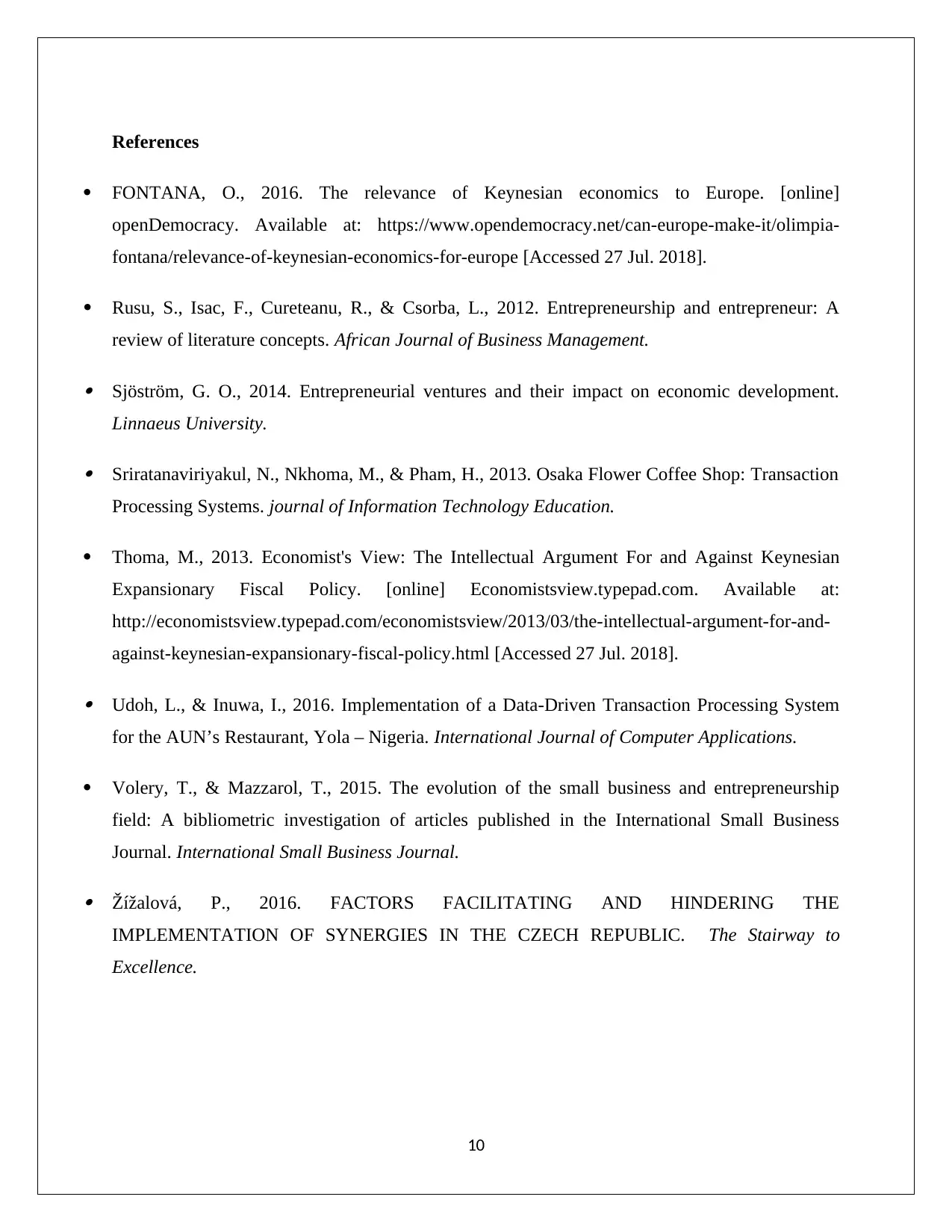
References
FONTANA, O., 2016. The relevance of Keynesian economics to Europe. [online]
openDemocracy. Available at: https://www.opendemocracy.net/can-europe-make-it/olimpia-
fontana/relevance-of-keynesian-economics-for-europe [Accessed 27 Jul. 2018].
Rusu, S., Isac, F., Cureteanu, R., & Csorba, L., 2012. Entrepreneurship and entrepreneur: A
review of literature concepts. African Journal of Business Management.
Sjöström, G. O., 2014. Entrepreneurial ventures and their impact on economic development.
Linnaeus University.
Sriratanaviriyakul, N., Nkhoma, M., & Pham, H., 2013. Osaka Flower Coffee Shop: Transaction
Processing Systems. journal of Information Technology Education.
Thoma, M., 2013. Economist's View: The Intellectual Argument For and Against Keynesian
Expansionary Fiscal Policy. [online] Economistsview.typepad.com. Available at:
http://economistsview.typepad.com/economistsview/2013/03/the-intellectual-argument-for-and-
against-keynesian-expansionary-fiscal-policy.html [Accessed 27 Jul. 2018].
Udoh, L., & Inuwa, I., 2016. Implementation of a Data-Driven Transaction Processing System
for the AUN’s Restaurant, Yola – Nigeria. International Journal of Computer Applications.
Volery, T., & Mazzarol, T., 2015. The evolution of the small business and entrepreneurship
field: A bibliometric investigation of articles published in the International Small Business
Journal. International Small Business Journal.
Žížalová, P., 2016. FACTORS FACILITATING AND HINDERING THE
IMPLEMENTATION OF SYNERGIES IN THE CZECH REPUBLIC. The Stairway to
Excellence.
10
FONTANA, O., 2016. The relevance of Keynesian economics to Europe. [online]
openDemocracy. Available at: https://www.opendemocracy.net/can-europe-make-it/olimpia-
fontana/relevance-of-keynesian-economics-for-europe [Accessed 27 Jul. 2018].
Rusu, S., Isac, F., Cureteanu, R., & Csorba, L., 2012. Entrepreneurship and entrepreneur: A
review of literature concepts. African Journal of Business Management.
Sjöström, G. O., 2014. Entrepreneurial ventures and their impact on economic development.
Linnaeus University.
Sriratanaviriyakul, N., Nkhoma, M., & Pham, H., 2013. Osaka Flower Coffee Shop: Transaction
Processing Systems. journal of Information Technology Education.
Thoma, M., 2013. Economist's View: The Intellectual Argument For and Against Keynesian
Expansionary Fiscal Policy. [online] Economistsview.typepad.com. Available at:
http://economistsview.typepad.com/economistsview/2013/03/the-intellectual-argument-for-and-
against-keynesian-expansionary-fiscal-policy.html [Accessed 27 Jul. 2018].
Udoh, L., & Inuwa, I., 2016. Implementation of a Data-Driven Transaction Processing System
for the AUN’s Restaurant, Yola – Nigeria. International Journal of Computer Applications.
Volery, T., & Mazzarol, T., 2015. The evolution of the small business and entrepreneurship
field: A bibliometric investigation of articles published in the International Small Business
Journal. International Small Business Journal.
Žížalová, P., 2016. FACTORS FACILITATING AND HINDERING THE
IMPLEMENTATION OF SYNERGIES IN THE CZECH REPUBLIC. The Stairway to
Excellence.
10
1 out of 10
Related Documents
Your All-in-One AI-Powered Toolkit for Academic Success.
+13062052269
info@desklib.com
Available 24*7 on WhatsApp / Email
![[object Object]](/_next/static/media/star-bottom.7253800d.svg)
Unlock your academic potential
Copyright © 2020–2025 A2Z Services. All Rights Reserved. Developed and managed by ZUCOL.





